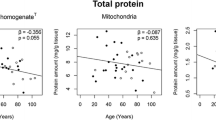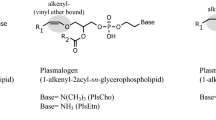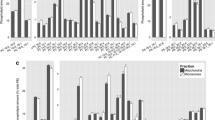Abstract
The two major phospholipid classes, namely, phosphatidylethanolamines (PE) and phosphatidylcholines (PC), were studied in four different regions of human brain,i.e., in frontal gray matter, frontal white matter, hippocampus and in pons. The fatty acid (FA) compositions of these phospholipids were found to be specific for the different regions. PC contains mostly saturated and 18∶1 FA, while PE is rich in polyunsaturated FA. Aging has no influence on the FA compositions, while in Alzheimer’s disease (AD) PE is modified in all four regions, particularly in frontal gray matter and in hippocampus. The abundance of the major monounsaturated FA of PE, 18∶1, is not significantly altered in Alzheimer’s disease, but there is a substantial increase in the relative amounts of the saturated components 14∶0, 16∶0 and 18∶0. This is paralleled by a decrease in the polyunsaturated FA 20∶4, 22∶4 and 22∶6. It is not clear whether the changes observed are specific for AD. Changes in saturated/polyunsaturated FA ratio are likely to influence cellular function, which in turn may cause certain neural deficiencies. The findings do not support the hypothesis that AD reflects an accelerated aging process.
Similar content being viewed by others
Abbreviations
- AD:
-
Alzheimer’s disease
- FA:
-
fatty acids
- GLC:
-
gasliquid chromatography
- NADH:
-
nicotinamide adenine dinucleotide
- PC:
-
phosphatidylcholine
- PE:
-
phosphatidylethanolamine
- PL:
-
phospholipids
- PUFA:
-
polyunsaturated fatty acids
- TLC:
-
thin-layer chromatography
References
Svennerholm, L. (1963)J. Neurochem. 10, 613–623.
Söderberg, M., Edlund, C., Kristensson, K., and Dallner, G. (1990)J. Neurochem. 54, 415–423.
van Dijck, P.W.M., de Kruijff, B., van Deenen, L.L.M., de Jier, J., and Demel, R.M. (1976)Biochim. Biophys. Acta 455, 576–587.
Valtersson, C., van Duyn, G., Verkleij, A.J., Chojnacki, T., de Kruijff, B., and Dallner, G. (1985)J. Biol. Chem. 260, 2742–2751.
Horrocks, L.A., Van Rollins, M., and Yates, A.J. (1981) inThe Molecular Basis of Neuropathology (Davison, A.N., and Thompson, R.H.S., eds.) pp. 601–630, Edward Arnold, London.
Stokes, C.E., and Hawthorne, J.N. (1987)J. Neurochem. 48, 1018–1021.
Ellison, D.W., Beal, M.F., and Martin, J.B. (1987)Brain Research 417, 389–392.
Bowen, D.M., Smith, C.B., and Davison, A.N. (1973)Brain 96, 849–856.
Brookshank, B.W.L., and Martinez, M. (1989)Mol. Chem. Neuropathol. 11, 157–185.
Khachaturian, Z.S. (1985)Arch. Neurol. 42, 1097–1104.
Morrison, W.R., and Smith, L.M. (1964)J. Lipid Res. 5, 600–608.
Cullis, P.R., and Hope, M.J. (1985) inBiochemistry of Lipids and Membranes (Vance, D.E., and Vance, J.E., eds.) pp. 25–72, Benjamin/Cummings, Menlo Park.
Vanderkooi, G. (1974)Biochim. Biophys. Acta 344, 307–345.
Hidalgo, C., and Ikemoto, N. (1977)J. Biol. Chem. 252, 8446–8454.
Stier, A., and Sackmann, E. (1973)Biochim. Biophys. Acta 311, 400–408.
Valtersson, C., and Dallner, G. (1982)J. Lipid Res. 23, 868–876.
Kishimoto, Y., Agranoff, B.W., Radin, N.S., and Burton, R.M. (1969)J. Neurochem. 16, 397–404.
Pullarkat, R.K., and Rena, H. (1978)J. Neurochem. 31, 707–712.
Gottfries, C.G. (1986) inProgress in Brain Research (Swaab, D.F., Fliers, E., Mirmiran, M., Van Gool, W.A., and Van Haren, F., eds.) Vol. 70, pp. 133–139, Elsevier, Amsterdam.
Jeffcoat, R. (1979)Essays Biochem. 15, 1–36.
Strittmatter, P., Spatz, L., Corcoran, D., Rogers, M.J., Setlow, B., and Redline, R. (1974)Proc. Natl. Acad. Sci. USA 71, 4565–4569.
Dhopeshwarkar, G.A., and Mead, J.F. (1973)Adv. Lipid Res. 11, 109–142.
Scheibel, M.E., and Scheibel, A.B. (1975) inClinical, Morphologic, and Neurochemical Aspects in the Aging Central Nervous System (Brody, H., Harman, D., and Ordy, J.M., eds.) Vol. 1, pp. 11–37, Raven Press, New York.
Cotman, C., Blank, M.L., Moehl, A., and Snyder, F. (1969)Biochemistry 8, 4606–4612.
Masliah, E., Terry, R.D., DeTeresa, R.M., and Hansen, L.A. (1989)Neurosci. Lett. 103, 234–239.
Author information
Authors and Affiliations
About this article
Cite this article
Söderberg, M., Edlund, C., Kristensson, K. et al. Fatty acid composition of brain phospholipids in aging and in Alzheimer’s disease. Lipids 26, 421–425 (1991). https://doi.org/10.1007/BF02536067
Received:
Revised:
Accepted:
Issue Date:
DOI: https://doi.org/10.1007/BF02536067




